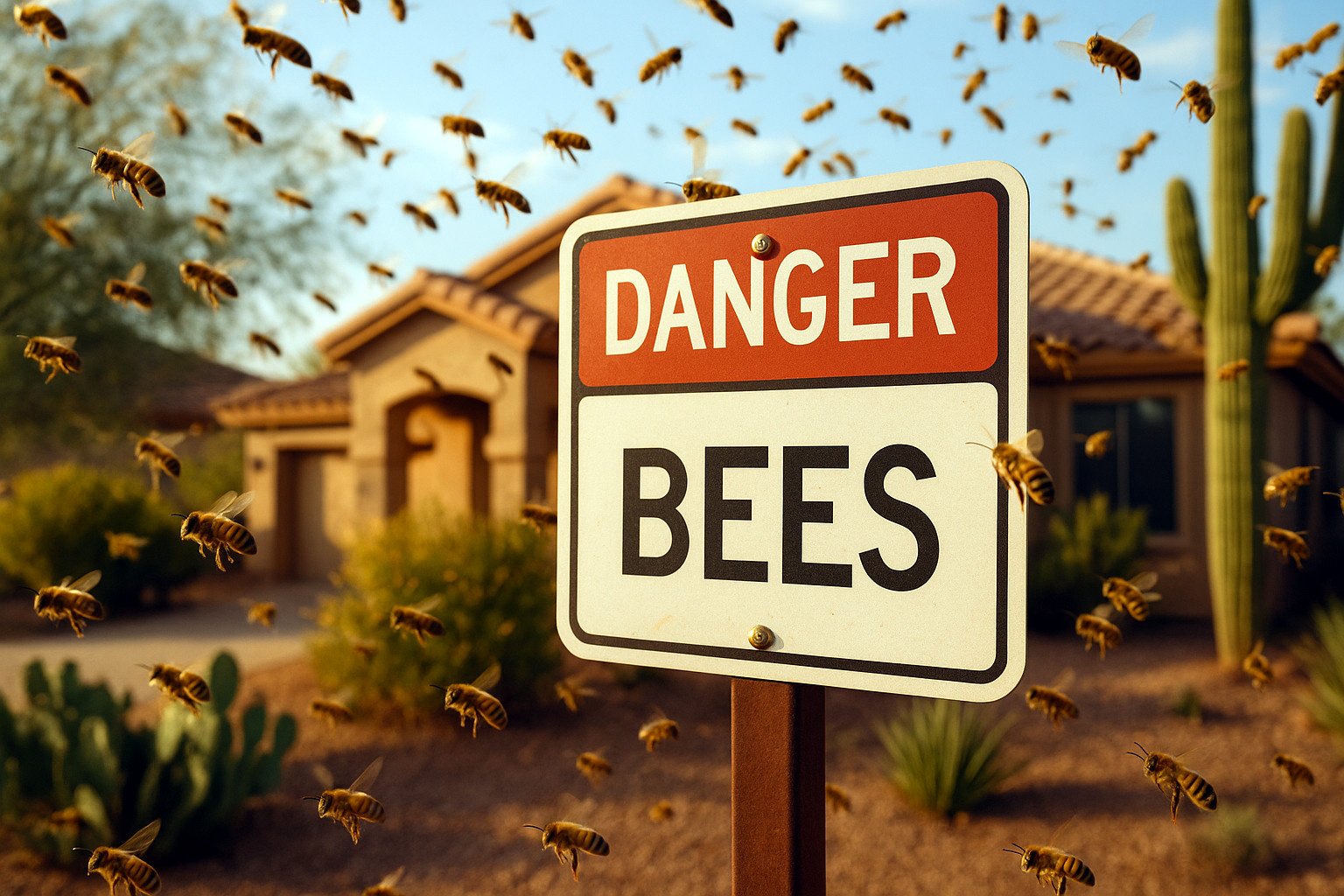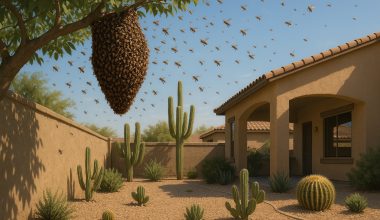Tragedy in Scottsdale: Why We Need to Talk About Bee Attacks
On July 7, 2025, a heartbreaking tragedy unfolded in North Scottsdale. A hardworking crew at the Vi at Silverstone Independent Living facility was simply doing their jobs, preparing a building for safe hive removal, when they unexpectedly disturbed an aggressive swarm of Africanized honey bees. In an instant, a routine workday turned into a life-threatening emergency—reminding us how suddenly danger can appear, even for those taking precautions.
What Occured?
- Worksite Accident: Three men were using a lift to remove stucco from a building column when they encountered a hidden hive of highly defensive Africanized bees (AZ Family, FOX 10 Phoenix).
- Immediate Consequences: The bees swarmed, attacking the workers with hundreds of stings. Nicolas Lopez Soto, age 65, collapsed on-site, received CPR, and later died at the hospital. Two coworkers were also hospitalized, suffering multiple stings (AZ Family, The Independent).
- Type of Bees: Experts confirm that over 90% of wild hives in Arizona are Africanized honey bees—renowned for their extreme defensiveness and tendency to attack in large numbers (AZ Family, Wikipedia).
Why This is Important
This was not a rare event—Africanized bee attacks are a real risk for anyone living or working outdoors in Arizona. It only takes one hidden hive to turn an ordinary workday into a life-threatening emergency. That’s why Bee Removal Phoenix is sharing this guide: so you and your loved ones know the facts, recognize the risks, and understand exactly what to do if the worst happens.
Why Africanized Bees Are So Dangerous in Phoenix
In Phoenix and throughout Arizona, nearly every wild hive you might encounter is now made up of Africanized honey bees—frequently called “killer bees.” While they may look almost identical to ordinary European honey bees, these hybrids are far more dangerous to people, pets, and anyone working outdoors.
What Exactly Are Africanized Bees?
Africanized bees are a cross between European honey bees and African honey bees. After being introduced by accident in Brazil in the 1950s, they spread quickly north and were first detected in Arizona during the early 1990s (Smithsonian, Wikipedia). Experts now estimate that more than 90% of wild bee colonies in the Phoenix area are Africanized hybrids (AZ Family).
Why Are They So Much More Dangerous?
- Extreme Defensiveness:
Africanized bees aren’t more venomous, but they are much more aggressive. They defend their hives by swarming and delivering thousands of stings at once, instead of just a few individuals attacking (USDA ARS, Smithsonian). - Chase Threats Farther:
Unlike typical bees, Africanized bees will pursue people and animals for up to a quarter mile (400 meters) if disturbed (NPS, Wikipedia). - Easily Provoked:
Ordinary household noises—like mowing, hammering, or even a passing vibration—can set them off. Just being near a hidden hive can spark an aggressive attack within seconds (USDA Forest Service).
How Many Stings Are Dangerous?
- For a healthy adult, 200–500 stings can be deadly, even if they aren’t allergic.
- For children, seniors, or those with underlying health conditions, much fewer stings may be life-threatening.
- For people with bee sting allergies, even one sting can cause a dangerous reaction known as anaphylaxis (CDC/NIOSH, University of Florida IFAS).
Why Are These Attacks So Serious?
It’s not just the bee, it’s the overwhelming number of stings delivered in seconds that make Africanized bee attacks so severe. These swarms are much more persistent and difficult to escape than encounters with regular honey bees (Smithsonian, NPS).
What To Do During a Bee Attack: Your Emergency Action Plan
If you ever find yourself under attack by bees in Phoenix, what you do in those first seconds is critical. Here’s how to protect yourself and your loved ones if the worst happens:
1. Run—Don’t Swat
- Move away from the hive or swarm immediately—run in a straight line as fast as you can.
- Don’t waste time trying to fight the bees; swatting only makes them more aggressive (NPS, USDA Forest Service).
2. Cover Your Face and Head
- Use your shirt, jacket, or hands to shield your face—especially your eyes, nose, and mouth.
- Most bee stings happen on the head and face (USDA ARS).
3. Never Jump in Water
- Do not dive into a pool or pond; Africanized bees will wait above the surface and continue stinging as soon as you come up for air (NPS, CDC/NIOSH).
4. Find Shelter Quickly
- Get indoors or into a car as soon as possible, and close all doors and windows behind you.
- If you’re driving, keep moving until you’re well away from the bees (USDA Forest Service).
5. Remove Stingers as Soon as You’re Safe
- Use a fingernail, credit card, or blunt edge to scrape out stingers—don’t pinch or squeeze, which injects more venom (CDC/NIOSH, University of Florida IFAS).
6. Get Medical Help if Needed
- Call 911 if you have trouble breathing, swelling, or are stung more than 15–20 times (less for children).
- If you’re allergic, use your EpiPen immediately and seek emergency care.
How to Prevent Bee Attacks at Home: Safety Tips for Phoenix Families
Bee safety isn’t just about reacting in an emergency—it’s about taking steps now to keep bees from becoming a danger on your property. Here’s what every Phoenix homeowner should know:
1. Inspect and Secure Your Property
- Check for gaps, holes, or cracks in walls, roofs, sheds, and utility boxes. Seal up any opening larger than 1/8 inch—bees only need a small space to move in (NC State Extension).
- Clear away debris, old equipment, and junk where bees could nest (UGA Extension).
2. Watch for Hive Activity
- If you notice bees coming and going from a single spot, or a “clump” of bees on a fence, tree, or structure, there could be a hidden hive nearby (NPS).
3. Don’t Attempt DIY Hive Removal
- Never try to spray or remove a hive yourself—even if you’ve got a bee suit.
Africanized bees can sting through poor-quality gear, and sprays can make them more aggressive. - Professional bee removal teams (like ours at Bee Removal Phoenix) use advanced suits, tools, and techniques for safe, effective removal.
4. Educate Your Family and Neighbors
- Make sure children know to avoid bees and to never disturb a hive.
- Share safety tips with neighbors, especially if you spot bee activity in shared spaces (USDA Forest Service).
Keeping Your Pets Safe from Bee Attacks in Phoenix
Pets are naturally curious, but that curiosity can put them at serious risk when it comes to Africanized bees. Every year in Phoenix, veterinarians treat dogs and cats for bee stings—and sadly, some cases are fatal.
Why Are Pets So Vulnerable?
- Dogs and cats often explore yards, sniff at holes, or chase buzzing insects—sometimes right into a hidden hive.
- Pets that are fenced in, leashed, or tied up often can’t escape if bees attack (Merck Vet Manual).
- Even a few stings can cause swelling and pain, but a swarm attack can be deadly—there are documented cases of dogs and other pets dying after receiving hundreds of stings (KABC/ABC7, People.com).
What to Do if Your Pet Is Stung
- Remove your pet from the area right away—carry them if necessary.
- Scrape out any visible stingers with a credit card or dull edge (don’t squeeze them).
- If your pet has trouble breathing, swelling, weakness, or is stung multiple times, get emergency veterinary help immediately (Texas A&M Vet Med).
Pet Prevention Tips
- Check your yard for bee activity, especially in corners, sheds, and irrigation boxes.
- Don’t let pets investigate buzzing noises or swarms.
- If you see bees or a hive, keep pets indoors and call a professional removal service right away.
Frequently Asked Questions
How many bee stings are dangerous for people or pets?
For a healthy adult, about 200–500 stings can be fatal, even if they’re not allergic. For children, the elderly, or pets, far fewer stings can be life-threatening.
Anyone with a bee allergy, even one sting can be dangerous (CDC/NIOSH, Merck Vet Manual).
How can I tell if the bees on my property are Africanized?
You usually can’t tell just by looking—they look almost identical to regular honey bees. If you notice extreme aggression, large swarms, or bees chasing people or animals, assume they may be Africanized and call a professional for help (Smithsonian).
Should I try to remove a hive or swarm myself?
No—DIY removal is extremely risky. Africanized bees are highly defensive and can attack in large numbers if disturbed. Always call a trained bee removal expert with the right equipment (USDA Forest Service).
Is it safe to use store-bought bee suits and spray?
No. Cheap bee suits often fail against Africanized bees, and using sprays can make bees more aggressive and increase the danger. Professionals use specialized gear and proven techniques for safe removal.
Don’t Take Chances—Call Bee Removal Phoenix
If you see bee activity or suspect a hive on your property, don’t risk your safety or the safety of your loved ones and pets. Africanized bees can turn a normal day into a medical emergency in seconds.
Contact Bee Removal Phoenix. Our team at Busy Bee is trained, equipped, and ready to handle bee problems safely—so you don’t have to.
Your family’s safety is our top priority. Don’t wait—let us help keep your home and pets safe.


